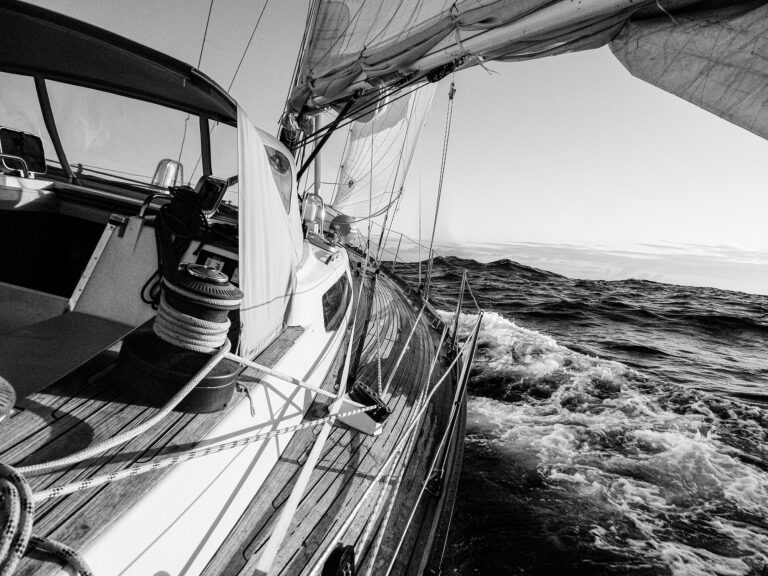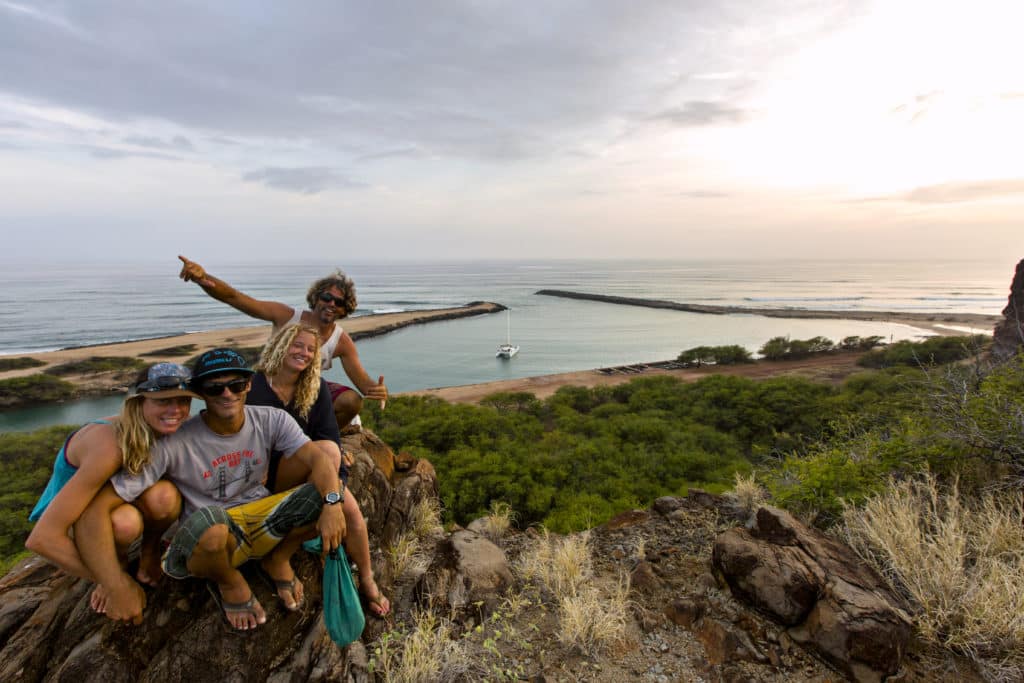
With a hand-rolled cigarette dangling from his mouth, in his thick French accent, Laurent Guiraudies explained to me the many merits of his custom-designed, home-built 55-foot catamaran, Azuline: “I say you, it is a really crazy boat, man! When you is on Azuline, it is always a good moment!” I looked up at the big rotating wing mast, and then aft at our twin wakes, which illustrated the story of a boat moving rapidly across a deep blue sea that had been whipped into a fury by 25 to 30 knots of reinforced trade-wind breeze.
Azuline’s stern was lifted slightly by a wave from behind, her bows angling down into the trough ahead. I pulled firmly with both hands on the tiller extension, in anticipation, to come down a few degrees in conjunction with the timing of the wave. Azuline launched forward on another long surfing run: 16 knots, then 18, then 20. We were hurtling toward the Hawaiian island of Oahu, propelled by the near-nuclear trades and the massive following sea state they’d constructed.
As Laurent screamed at me, the volume and excitement in his voice built in accordance with our boat speed: “21.9 knots! Yeah, man, you is the new champion, my friend!” At close to 22 knots, it was the fastest I’d ever gone on a cruising sailboat. Yes, a crazy boat indeed. God, I love the French.
We were on our way back from an epic five-day trip from Honolulu to Molokai during Hawaii Pacific University’s spring break. Crazy Frenchman Laurent was the skipper, and I was the experienced sailing hand. Along for the ride were two of my accomplices from school, Jerre and Kama, and two adventurous girls who’d rather play in the water than work for the week. We had a good crew.
And those rough and windy conditions that we experienced on the return trip were the antithesis of what we’d seen on the light-air journey from Oahu to Molokai at the outset.
With four surfers in our six-person crew, we knew we were in for good things when we departed Honolulu’s Ala Wai Harbor early on a Sunday to find glassy conditions and a reinforced groundswell lighting up Hawaii’s south-facing shores and reefs with clean, peeling waves. Just outside the channel, we hoisted Azuline’s big, roachy mainsail and small working jib and motorsailed slowly upwind in very light air. Savoring coffee, a light breakfast and our surroundings, we considered it a “good moment” to kick off the week.
Cruising parallel to Waikiki’s famed surfing and tourist beaches, each of us watched with interest as scores of surfers rode waves on what is quite possibly the single most popular surfing beach on the planet. Farther along, we passed Diamond Head, one of Hawaii’s most iconic physical features. After the famed volcanic cone, the coastline became considerably less developed as it fell away toward Koko Head and gradually was left astern. In what seemed like an instant, the chaos of Honolulu and Waikiki had become the serenity of the Kaiwi Channel (more commonly referred to as the Molokai Channel). Kristen, a marine biologist, and Erika, a scuba instructor, both wanted to swim, so we dropped the jib and eased the main.
That’s when we saw the whales.
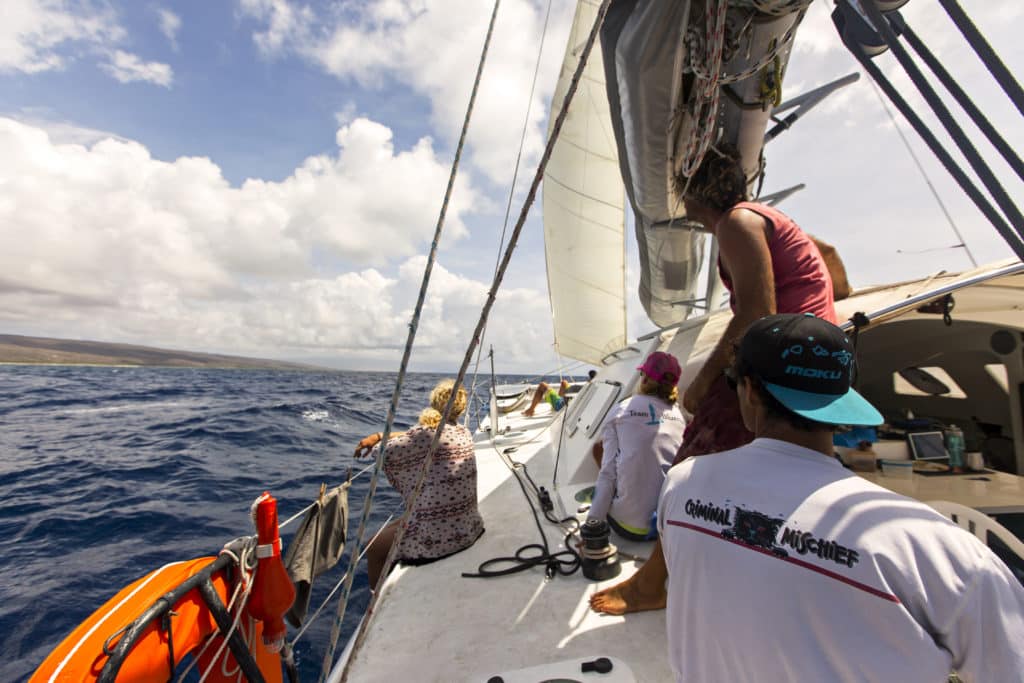
Like many creatures that live in less pleasant climates, humpback whales and other big marine mammals migrate to Hawaii en masse to escape the clutches of winter. Our early-March trip was primed for their company, as they reside in the warm and hospitable island group from roughly December to April. “Have you ever heard them sing before?” Kristen asked me. I hadn’t.
Azuline sat motionless in the channel, floating on a glassy sea with a pod of humpback whales cruising by just a hundred meters away. “Come,” she said, as she grabbed my hand and jumped off the port side. Free-diving gracefully below the surface, she motioned for me to follow. Clearing my nose, I dived down a few feet and was shocked to hear the many high-pitched whines and songs of the majestic creatures filling the sea around me. An experienced offshore sailor, I’d seen whales in the ocean countless times and had admired them for years. Heck, I’d even crash-tacked my Cal 2-27 to avoid one, but I had never before heard them sing. Eight miles from land and three hours into the trip, and my mind had already been blown. It was going to be a good week.
Long, skinny and east/west-oriented, like the state of Tennessee, the island of Molokai lies just 25 nautical miles east of Oahu yet seems a world apart. Known in Hawaii as the “Friendly Island” — and arguably most famous for being the site of an abandoned leper colony — the expansive isle is home to just 7,000 residents.
We discovered this fact about the sparse population upon making our approach to our first anchorage on Molokai. Located on the southwest side of the island, the tiny man-made harbor of Hale O Lono (“House of the Gods”) is a rustic place on an island full of them. There are no buildings along the shore, no other boats in the harbor, and our phones didn’t even work. No docks, no mooring balls, no harbor office — just a broken-up old concrete wharf, a bunch of Porta-Johns, and a few friendly local families, whose kids greeted us with shouts of “aloha.”
Unleashed on our own private-island paradise on the first day of vacation, none of us wasted any time in making ourselves scarce. Kama, Kristen, Laurent and I were all keen to surf, while Erika and Jerre wanted to paddle, shoot photos and dive in to go snorkel.
With no travel guide, local knowledge, or idea of what to expect, the four of us paddled out of Hale O Lono to observe our surroundings. The harbor’s western breakwall picked up the south-southwest swell and made a right-hand point break that looked good but proved unridable, so we paddled east. The waves weren’t great, but they were big, they were there, and we were on spring break, so we made do. Ingrained into my mind is an image of Kama, his stance wide and weight well aft to compensate for the steep wave face, dropping into a head-high wave with a massive green sea turtle right next to his head, getting tumbled in the surf.
Later that evening, we went ashore on our stand-up paddleboards to take a hike. After making our way to the vantage point that overlooked Hale O Lono Harbor and offered the best view of Azuline resting gently at anchor, we then dispersed to explore on our own accord. Kristen and I went searching for a better spot to surf the following morning. Walking down a makeshift road, we came upon two men barbecuing by the beach. “Did you see those four people surfing right out front here earlier this afternoon?” one asked. Kristen shot me a sheepish grin before admitting that it was us. “No one ever surfs out there,” the man said.
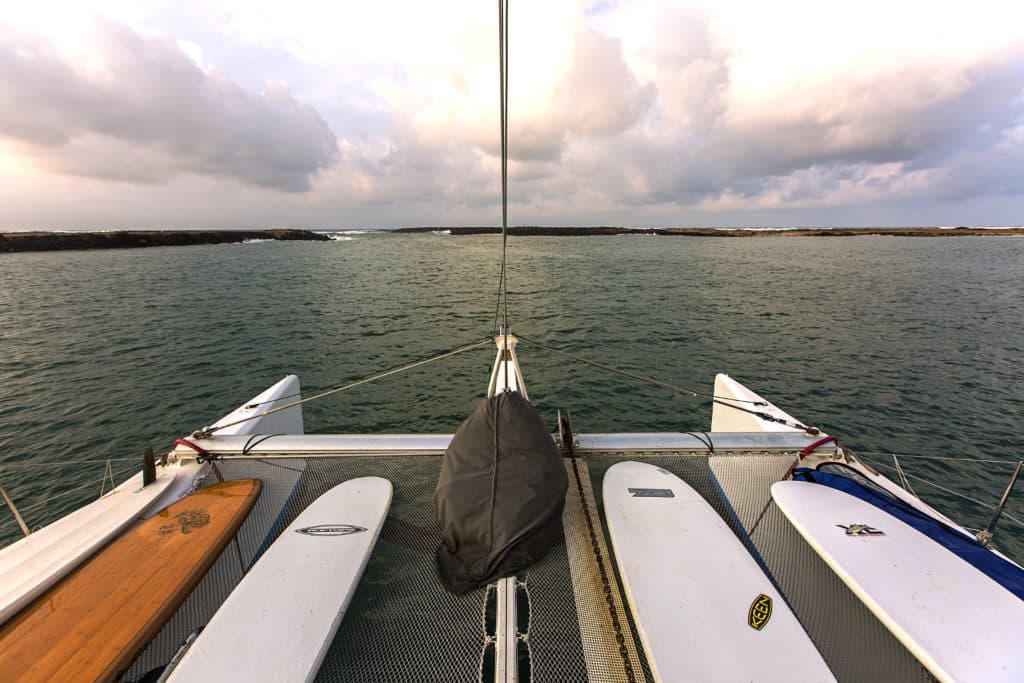
Having left the crowded surf breaks of Waikiki just that morning, I was completely in awe of how different the scenery and surroundings could be just a couple of dozen miles to the east. I looked again at the sea and the coast in a state of amazement; it didn’t quite make sense. Back in Honolulu, the real estate is so valuable that developers have resorted to simply building taller buildings, as purchasing more land isn’t feasible. A proverbial stone’s throw away, and there was nothing. The contrast to nearby Oahu was almost too much to believe, but in that contrast I found beauty.
Later that night, it was back to Azuline to celebrate a successful first day on our journey. We had departed on time, swum close to whales in the channel, surfed rugged and challenging head-high waves, and explored a tiny portion of this heretofore-mysterious island. Our easily excitable French skipper was beyond stoked and wanted to “make a party,” so make a party we did. The vibe on board Azuline was decidedly good. And no one has truly lived until they’ve dined on a veggie burger fried in duck fat by a jovial Frenchman and served with a side of foie gras at anchor. “Superbe!”
The next day we were back on the beach, and so were the guys with the grill, set up in the back of their pickup. “There’s always waves here,” said our newfound friend as he offered us burgers, as well as some local knowledge.
“Molo means ‘to twist,’ and kai means ‘sea,'” he said, spreading ketchup and mayonnaise on the bun with his finger. “When the swells are from the northwest in the winter, they wrap around to the south side. When they’re from the south in the summer, they break right onshore.”
Once again, Kristen, Kama, Laurent and I paddled out to our own private surf break, which was seeing that trace northwest swell wrap combined with the still-holding south swell to create a free-for-all of waves for our own personal enjoyment. Kristen figured it out first and lined up a nice right-hander. Several shouts of “Chee-hoo!” emanated from our group as she showed us the way, her blond ponytail flying as she accelerated across the wave face. Once we all had it wired, we named the break “Azuline’s” in honor of our host, Laurent, and his incredible catamaran. The four of us then traded waves to our heart’s content, gorging ourselves on the abundance of nature that our private paradise had again provided us.
Laurent Guiraudies and his custom-built catamaran, Azuline, were a truly unique and entertaining combination, both at sea and in harbor. The big 55-foot cat was custom-designed and built on a beach in Tahiti in the mid-1990s by her original owner, another Frenchman, out of plywood and epoxy.
With lifting rudders and daggerboards, twin tillers, a big rotating wing mast, and a Spartan interior, Azuline had intentions as clear as the sky above. She was built to be light, fast and simple, with sailing performance clearly a much higher priority than the luxuries found on most production cruising cats. There was no radar, indoor helm station, deep freezer or air conditioning. Hell, there wasn’t even a real head on board, just a big hole with a toilet seat mounted on top.
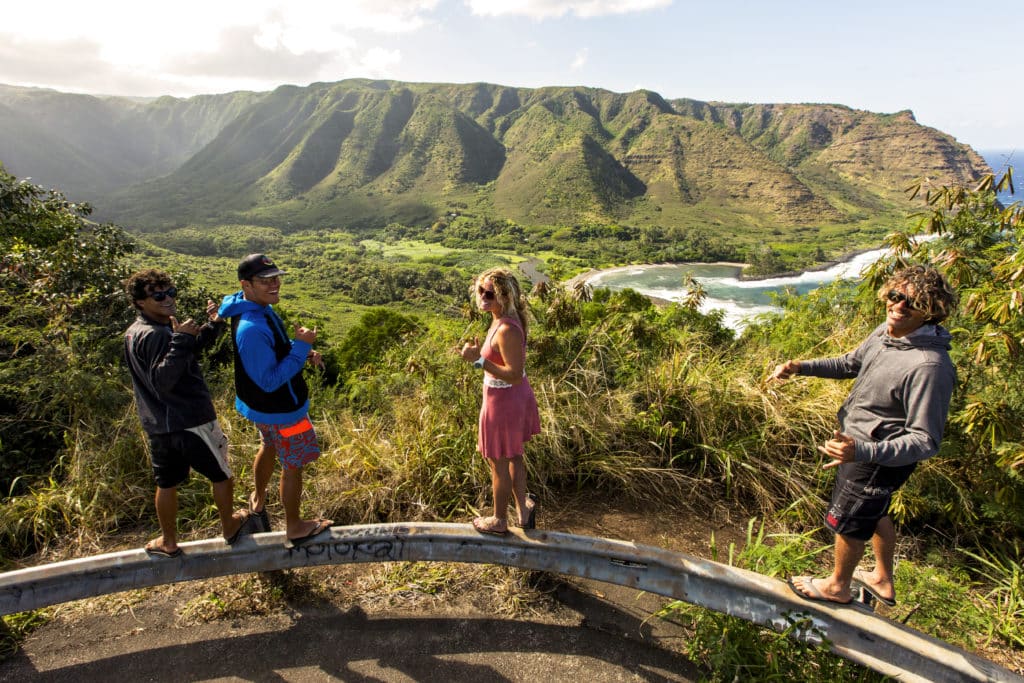
This design philosophy of creating a simple, lightweight vessel with 55 feet of waterline produced a boat that can eat up ocean miles quickly. With her original owner, five years after her launching, Azuline cruised from Tahiti to Patagonia and back. Two owners later, some 20 years after her launch, the distinctive white cat with its blue trim fell into Laurent’s hands in June 2014. After selling his Jeanneau sloop, The Shelter, Laurent secured a bank loan and purchased Azuline to both live aboard and operate as a day-charter vessel. Sailing the boat nearly daily out of Raiatea, Tahiti’s second-largest island, he enjoys nothing more than exposing his guests to the beauties of French Polynesia and the joy of sailing a unique high-performance vessel in paradise.
“This life, it is for the living, you know?” he said, his signature grin and ever-present sparkling eyes the very essence of joie de vivre. Raised in the southwest of France and with a degree in engineering, from day one, Laurent fought what he felt was his predetermined fate as a desk-ridden engineer.
In university, rather than study for exams, he spent his free time securing a license as a lifeguard and surf instructor. After graduation, when tasked with satisfying his 12 months of compulsory service in the French military, he failed his psych evaluation, convincing the doctors that he was mentally challenged with permanent brain damage from hard drug use. He wears his “psychologique Class 4″ designation as a badge of honor.
“I believe Class 4 is the maximum of crazy,” Laurent said, pridefully. “I didn’t want to go! I want my life to be about surf and love, not about war.” As a combat-wounded veteran of the Iraq War who has traded his machine gun for a big-wave gun and moved to the tropics on a sailboat, I see eye to eye with Laurent on most aspects of life. I suppose you could call us both kindred spirits.
The swells continued pumping, but we were growing anxious to see more of Molokai. Once back from our obligatory morning surf session, we decided to weigh anchor for the port of Kaunakakai, about 13 miles away. The channel to Hale O Lono had begun to close out periodically with breaking waves, making our departure all the more exciting. Once the anchor was up and there appeared to be a lull in the surf, we quickly made the decision to motor full throttle for the narrow opening. Escaping without drama, we watched in amazement as, just 30 seconds after our departure, a four-wave set exploded into the channel. “On Azuline, it is always a good moment!” reiterated Laurent, ever the jokester. I heartily concurred.
As a large low-pressure system passed just north of the state, the Hawaiian Islands were blanketed in fresh westerlies, creating a rare downwind run from Hale O Lono to Kaunakakai. Immediately out of the harbor, we set just the working jib and cruised downwind at a lazy 5 or 6 knots. The sea had been churned into a frothy cauldron, but with Molokai to our north and the island of Lanai now to our south, the ride remained smooth as we savored the day.
And then we saw more whales.
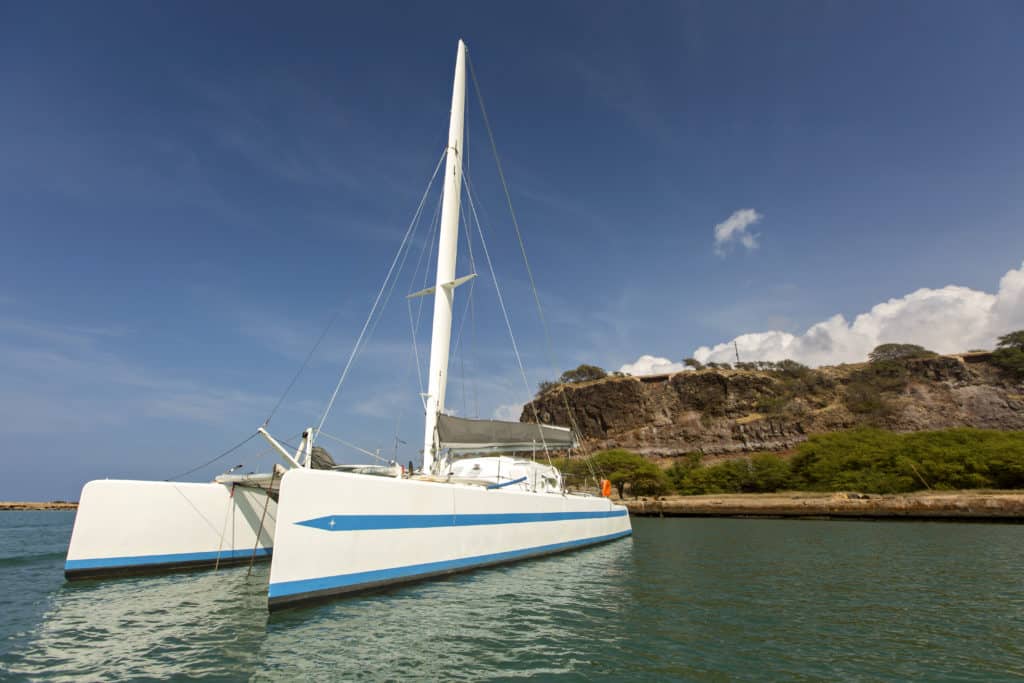
Not one, not two, but whales in almost every direction. Some breached in the distance — some closer, one right in front of us. I quickly disengaged Azuline’s autopilot, Michel (named in honor of double Vendée Globe winner Michel Desjoyeaux), and took the helm while the rest of the crew enjoyed the show from the forward trampoline. One breached right to starboard, while another almost fully cleared the water to port. We were surrounded, and the massive creatures were too close for comfort. Laurent and I — the only two skippers and boat owners aboard — exchanged a glance that said all that needed to be said (if put into words, it wouldn’t be suitable for this publication). But once it became clear we were safe from impact, Laurent cleared his throat and struggled to make light of the situation: “Ahem, when you is on Azuline, man, it is always a good moment!” Yeah, I got that part.
Once we were anchored in Kaunakakai, the front came through as a whiteout squall with driving rain and gusty westerly winds. Despite a rather precarious lee shore with a wharf behind us, Azuline was a perfectly comfortable shelter to weather the storm, which lasted the rest of the day. After a few days of land and sea adventures, close calls, and many “good moments” together, our crew of six had bonded and acclimated to life aboard the good ship Azuline. While stuck on board, meals, drinks, games, conversation and impromptu parties passed the time. Then we had two days of blue skies to explore more of the island.
Kaunakakai is Molokai’s most populous city, housing approximately half of the island’s residents. With this in mind, despite the close proximity to Oahu, it’s easy to comprehend just how remote and sparsely populated the so-called Friendly Island really is. A traffic jam in Kaunakakai happens when two cars stop and wave at each other before motioning who goes first (there’s not a single stoplight on the entire island). With a downtown spanning just three blocks and a bakery as one of its biggest attractions, Kaunakakai is as different from most big cities as one can get. Everyone has plenty of time to “talk story” with you. The pace and vibe are notably relaxed.
Hiking high above the city, we reveled in the views of Kaunakakai and the fringing reef to both the east and west before renting a Ford F-150 and touring the rest of the island. Visiting an outlook above Kalaupapa’s infamous leper colony and then riding around in the back of a pickup on Molokai’s beautiful windward shores afforded a rare opportunity to discover more of this majestic, secluded island. Like the rest of the Hawaiian Islands, it is completely unique unto itself and constantly evolving. With dramatic mountains, valleys and sea cliffs forged by some 2 million years of fresh trade winds, and frequent rainfall and harsh weather, Molokai is as rugged as it is beautiful. On this day alone, we witnessed 20-foot northwest swells pounding the north and west coast while 30-knot north-northeast winds churned up boisterous seas. It was perfect to psych us up for our spirited return voyage to Oahu the following morning.
One month later, Laurent made his final preparations to set sail for Tahiti. From the local yacht club he had picked up two crew, and the weather looked right for a quick and breeze-on departure from the islands. As is the constant plight of the bluewater sailor, it was time to say goodbye to a dear friend. Three months earlier, we had both sailed into Honolulu within three days of each other, Laurent on vacation from French Polynesia and I from California to attend college. Since that time, we had shared many special moments together. When Azuline and crew set sail from Waikiki’s Ala Wai Harbor on a Sunday in April, I took solace in the fact that I knew I would see my friend again one day. For now, I just wanted him to have a safe and enjoyable passage home. As we parted ways this time, I told him: “I say you, man, when you is on Azuline, it is always a good moment. Bon voyage, mon ami.”
Ronnie Simpson is a sailor, surfer and writer who lives in Honolulu and is currently pursuing a degree in integrated multimedia and journalism at Hawaii Pacific University. Soon after their trip on Azuline, Kristen and he became engaged. Ronnie is also the co-founder of a wounded-veterans sailing nonprofit (coreveterans.org).







